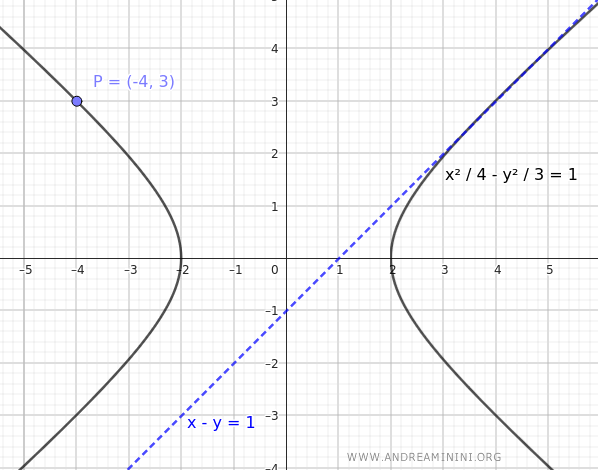Finding the Equation of a Hyperbola Given a Point and a Tangent Line
To determine the equation of a hyperbola centered at the origin, given a point on the hyperbola \( P(x,y) \) and the equation of a tangent line, follow these steps:
- First, decide whether the transverse axis lies along the x-axis $$ \frac{x^2}{a^2} - \frac{y^2}{b^2} = 1 $$ or the y-axis $$ \frac{x^2}{a^2} - \frac{y^2}{b^2} = -1 $$ based on the information provided.
- Next, substitute the coordinates of the point \( P(x,y) \) into the standard equation of the hyperbola.
- Compare the equation of the given tangent line with the standard form of a tangent line to a hyperbola, \( \frac{x_0x}{a^2} - \frac{y_0y}{b^2} = 1 \), to find the coordinates \( (x_0, y_0) \) of the point of tangency in terms of \( a^2 \) and \( b^2 \). Then, substitute these values into the equation of the tangent line.
- Finally, set up a system of equations to solve for \( a^2 \) and \( b^2 \).
A Practical Example
Consider a hyperbola centered at the origin, with its transverse axis along the x-axis. Suppose it passes through the point \( P(-4,3) \) and has a tangent line given by \( x - y = 1 \).
Since the transverse axis is along the x-axis, the standard equation of the hyperbola is:
$$ \frac{x^2}{a^2} - \frac{y^2}{b^2} = 1 $$
Given that the hyperbola passes through the point \(P(-4, 3)\), we can substitute \(x = -4\) and \(y = 3\) into the standard equation to obtain:
$$ \frac{16}{a^2} - \frac{9}{b^2} = 1 \quad \text{(Equation 1)} $$
We also know that the hyperbola has a tangent line defined by the equation \(x - y = 1\).
For a hyperbola, the equation of the tangent line at a point \((x_0, y_0)\) is given by:
$$ \frac{x_0x}{a^2} - \frac{y_0y}{b^2} = 1 $$
Comparing this with the given tangent line equation \(x - y = 1\), we can identify the following:
$$ \underbrace{ \frac{x_0}{a^2} }_1 x - \underbrace{ \frac{y_0}{b^2} }_1 y= 1 \Leftrightarrow x-y=1 $$
To match the coefficients of \(x\) and \(y\) in the tangent line equation, we must have:
$$ \frac{x_0}{a^2} = 1 \quad \text{and} \quad -\frac{y_0}{b^2} = -1 $$
This implies:
$$ x_0 = a^2 \quad \text{and} \quad y_0 = b^2 $$
Therefore, the point of tangency \((x_0, y_0)\) on the hyperbola is \((a^2, b^2)\).
Since this line is tangent at this point, we can substitute \(x = a^2\) and \(y = b^2\) into the tangent line equation \(x - y = 1\) to get:
$$ a^2 - b^2 = 1 \quad \text{(Equation 2)} $$
Now we have two equations to solve simultaneously, forming a system with two equations and two unknowns:
$$ \begin{cases} \frac{16}{a^2} - \frac{9}{b^2} = 1 \\ \\ a^2 - b^2 = 1 \end{cases} $$
Let's solve for \( a^2 \) from the second equation:
$$ a^2 = b^2 + 1 $$
Next, substitute \( a^2 = b^2 +1 \) into the first equation:
$$ \frac{16}{b^2 + 1} - \frac{9}{b^2} = 1 $$
$$ \frac{16b^2 - 9(b^2+1)}{b^2(b^2 + 1)} = 1 $$
To solve the first equation, multiply both sides by \(b^2(b^2 + 1)\):
$$ 16b^2 - 9(b^2 + 1) = b^4 + b^2 $$
Expanding and rearranging the terms gives:
$$ 16b^2 - 9b^2 - 9 = b^4 + b^2 $$
$$ 7b^2 - 9 = b^4 + b^2 $$
$$ b^4 - 6b^2 + 9 = 0 $$
Substituting \(u = b^2\), the equation \( b^4 - 6b^2 + 9 = 0 \) becomes:
$$ u^2 - 6u + 9 = 0 $$
This quadratic equation factors as:
$$ (u - 3)^2 = 0 $$
So, \(u = 3\), which means \(b^2 = 3\).
Now we can solve for \( a^2 \):
$$ \begin{cases} b^2=3 \\ \\ a^2 = b^2 + 1 \end{cases} $$
Substituting \(b^2 = 3\) into \(a^2 = b^2 + 1\), we find:
$$ a^2 = 4 $$
Thus, with \( a^2 = 4 \) and \( b^2 = 3 \), the standard equation of the hyperbola is:
$$ \frac{x^2}{4} - \frac{y^2}{3} = 1 $$
This is the equation of the hyperbola that passes through the point \((-4, 3)\) and has a tangent line given by \(x - y = 1\).

And that’s how it’s done.
